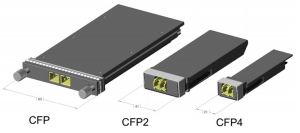With the economics-driven growth of global regional and local fiber communication network over the past few decades, 100 Gigabit Ethernet, a high-speed computer network technology was first defined by the IEEE 802.3ba-2010 standard. The recent rapid increase in the volume of communications traffic has led to a spread of 100G Ethernet for transmitting Ethernet frames at rates of 100 gigabits per second. In order to meet the data transmission needs, a high-performance and flexible implementation of 100G Ethernet - 100G optical transceiver has now started to ship into the market.
What Is 100G Transceiver
100G transceiver is designed to offer 100 Gigabit Ethernet connectivity options for data center networking, enterprise core aggregation, and service provider transport applications. So far, a series of module form factors have been developed to support the 100Gbps Ethernet, including CFP, CXP, CFP2, CFP4, QSFP28, etc. Next, this article will give you a look at how the CFP developed during the past few years.
The Development of CFP
When the IEEE finished the first 100G standard for Ethernet networks, the transceiver industry launched an alphabet soup of form factors. The first 100G transceivers have been based on the C form-factor pluggable (CFP) module, which is a large module capable of handling up to 24 watts of power dissipation. First-generation transceivers with multiple chips and large power requirements have used this module, which is specified by a multisource agreement. The CFP MSA defines hot-pluggable optical transceiver form factors to enable 40 Gb/s and 100 Gb/s applications. But CFP is primarily developed for 100 Gigabit Ethernet systems where the CFP modules use the 10-lane CAUI-10 electrical interface. CFP module measures 82 mm (3.22 inches) by 14 mm (0.55 inches), making it a large module that takes up a lot of space on the front panel of a switch or router. CFP MSA has defined the module factors that emphasize flexibility at the expense of its large size. The CFP transceivers are compliant with the CFP MSA, IEEE 802.3ba and OTU4 specified in ITU-T.
What Is 100G Transceiver
100G transceiver is designed to offer 100 Gigabit Ethernet connectivity options for data center networking, enterprise core aggregation, and service provider transport applications. So far, a series of module form factors have been developed to support the 100Gbps Ethernet, including CFP, CXP, CFP2, CFP4, QSFP28, etc. Next, this article will give you a look at how the CFP developed during the past few years.
The Development of CFP
When the IEEE finished the first 100G standard for Ethernet networks, the transceiver industry launched an alphabet soup of form factors. The first 100G transceivers have been based on the C form-factor pluggable (CFP) module, which is a large module capable of handling up to 24 watts of power dissipation. First-generation transceivers with multiple chips and large power requirements have used this module, which is specified by a multisource agreement. The CFP MSA defines hot-pluggable optical transceiver form factors to enable 40 Gb/s and 100 Gb/s applications. But CFP is primarily developed for 100 Gigabit Ethernet systems where the CFP modules use the 10-lane CAUI-10 electrical interface. CFP module measures 82 mm (3.22 inches) by 14 mm (0.55 inches), making it a large module that takes up a lot of space on the front panel of a switch or router. CFP MSA has defined the module factors that emphasize flexibility at the expense of its large size. The CFP transceivers are compliant with the CFP MSA, IEEE 802.3ba and OTU4 specified in ITU-T.
As the 100 Gb/s media interfaces evolve, they are becoming more efficient and being upgraded with faster internal paths for transmitting signals. The improvements in electrical signaling standards make electrical signals achieve 25 Gb/s on high-volume chip and card interfaces. Based on these new standards for electrical signaling, fewer lanes are needed, resulting in fewer connections. For that reason, a new generation of CFP - CFP2 was first demonstrated in 2012. The CFP2 optical transceivers appear to be more compact, and the size is reduced compared to CFP. The CFP2 transceivers use the 10-lane CAUI-10 electrical interface or the 4-lane CAUI-4 electrical interface. They are compliant with the CFP MSA, IEEE 802.3ba and OTU4 specified in ITU-T recommendations, and CFP2 transceivers double front panel port density compared to CFP transceivers.
The other upgraded version of CFP is CFP4 optical transceiver which was demonstrated in October 2013. CFP4 transceiver is nearly the half size of CFP2 transceiver. It achieves lower power consumption and quadruples front panel port density in comparison to CFP2 transceiver. CFP4 transceiver is compliant with the CFP4 MSA and IEEE 802.3bm by using the 4-lane CAUI-4 electrical interface.

Compared with CFP optical transceiver, the smaller CFP2 and CFP4 optical transceiver use fewer electrical connections into the switch, and thus support fewer lanes. Using fewer lanes means that each lane must signal at a higher rate, such as 25 Gb/s. These new transceiver modules are using the latest technology based on the newer OIF (Optical Internetworking Forum) signaling standards, combined with advances in circuit integration that require less power for the transceiver.
Fiberstore provides various kinds of 100G transceivers including 100G-SR10 CXP, 100G-SR10 CFP, 100G-LR4 CFP2 and so on. CFP, CFP2 and CFP4 optical transceivers will support the ultra-high bandwidth requirements of data communications and telecommunication networks that form the backbone of the internet.
Fiberstore provides various kinds of 100G transceivers including 100G-SR10 CXP, 100G-SR10 CFP, 100G-LR4 CFP2 and so on. CFP, CFP2 and CFP4 optical transceivers will support the ultra-high bandwidth requirements of data communications and telecommunication networks that form the backbone of the internet.
Originally published at http://www.sfp-transceiver-modules.com/wiki_list
No comments:
Post a Comment